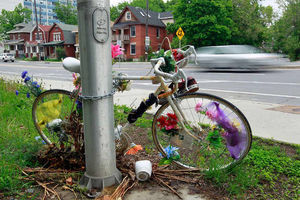Kirsty Bosley: Place to mourn a loved one shouldn't be roadside shrine
When I told my boyfriend the subject of this week's column, he looked at me with his teeth gritted, slightly squinting as though I'd thrown a handful of sand in his face at the beach, rather than an idea.

It's not that he didn't fully agree with me ('I 70 per cent agree with you,' he told me, whatever that means). But he was concerned the issue was too contentious to tackle, that maybe I sounded harsh and that it might be one best parked for late night wine conversation, rather than a column in a much-loved and well respected newspaper.

The more I thought about it, the more I began to '70 per cent' agree with him.
Was it too dangerous to open this can of worms? Was I ready for the inevitable influx of frustration from readers who were too angry to read all the way to the end before lambasting me for sharing the controversial opinion? Did I really want to touch upon this subject?
Well, what kind of columnist would I be if I ran away from emotionally charged, touchy conversation points? A rubbish one, likely (now, now. Be nice).
So here it is, and please finish reading it before you get mad at me. Promise? OK, then I'll begin.
At the bottom of the street where I grew up in, the place I played out on my bike a thousand times, is the scene of a horrible accident. What seems now like ages ago, a teenager was hit by a car there while out on his own bike and was killed.
I remember when it happened, and it was awful. It was the worst thing that can happen in any community – a shocking, heartbreaking occurrence, and something no one could get their head around. How could it have happened? It was devastating.
The street became a place of grief and mourning as the boy's family and friends flocked there to place flowers. A place where such a horrible thing had unfolded became one filled with people and colour.
As time went on, more flowers arrived. A football shirt was hung around the lamp post, along with other objects the boy had clearly held dear. More came, and the area became almost shrine-like, a temporary memorial to the poor child that had lost his life there.
But as time went on, it became less temporary. The flowers withered and died, but the scarves, shirts and now graffiti messages of 'RIP' and 'miss you' remained.
This is where it gets a bit testy. For me, as a person who lived there, it was time for someone (the family? The council?) to get rid of these symbolic bits of clutter. How long will they stay there? And who makes the decision to move them? Whose responsibility is it to maintain the area? Should it be allowed to becoming a long term go-to place for the grieving?
Please don't misunderstand me; I have absolute sympathy for the family of the boy. I can't and don't want to understand just how terrible it must be to lose a child. Nothing will ever make that better, and the passing of time must be irrelevant when you're feeling pain so agonisingly intense. And so for those experiencing it, it must be there's never a right time to pack up the teddies and trinkets. But what does that mean for everyone else living there?
No scarf on a lamp post or flowers at the scene will repair the damage done. I'm not saying they actively bothered me by being there, I just began to feel enough was enough after months and months. The shirts and scarves are dirty now and the flowers long dead.
The place where this poor boy died is a community area, a space hundreds of people pass daily.
I know grief is different for everyone, but for how long should they remain, and where do you draw the line? It's not a dedicated bench or a memorial stone or plaque – it's just a street where many other children will ride their bikes in the years to come.
I remember back when Madeleine McCann went missing. The people of the small town of Willenhall created a shrine in the marketplace, leaving flowers, teddies, cards and messages for the girl and her family. I couldn't understand it. I didn't know how cluttering up a massive space that needed to be used for the practical purpose of trading would make anything better. And I didn't see how those letters, that would go unread by Madeleine's parents, were possibly helping the situation. Fortunately, I have never had to go through the horror of what they're experiencing, and I hope I never will. Unless that happens, I won't know what difference it can make; that strangers in a place I've never heard of dedicate a big chunk of their marketplace to teddies and candles.
I'm not one to judge how others handle woe and heartache – I know that. I'm a practical person, I think. In moments of grief or torment, I mill around trying to be practical. Putting the kettle on, making phone calls and arrangements. The last thing I think to do is pop to Clintons to pick up a Tatty Teddy toy to go and put outside in the rain as a physical demonstration of my sadness.
The Willenhall shrine to Maddie was the scene of much uproar a little while after it's creation, when a councillor put her foot down and made the decision to clean it up. I understood exactly why she'd make that call, even though it was an unpopular one. At what point do you have to stand back and say enough is enough? If we leave flowers, scarves, shirts and letter memorials everywhere for anyone lost, we'd be trudging the streets knee-deep in the stinking brown sludge normally reserved for the bottom of a grave-top flower holder.
And that's exactly where I think these memorials should be left, in gardens of remembrance, on graves and at specially-created monuments. There are only so many lamp posts and telegraph poles to decorate.





